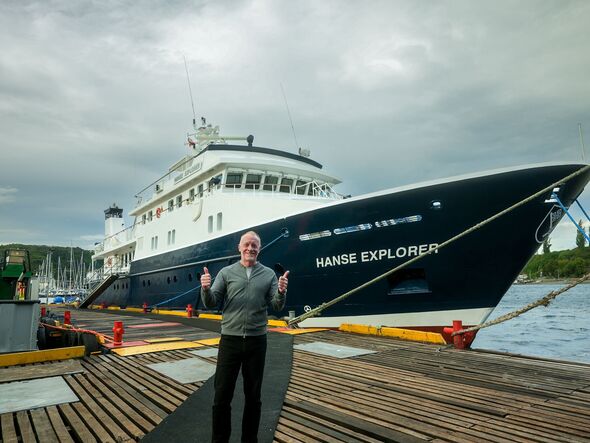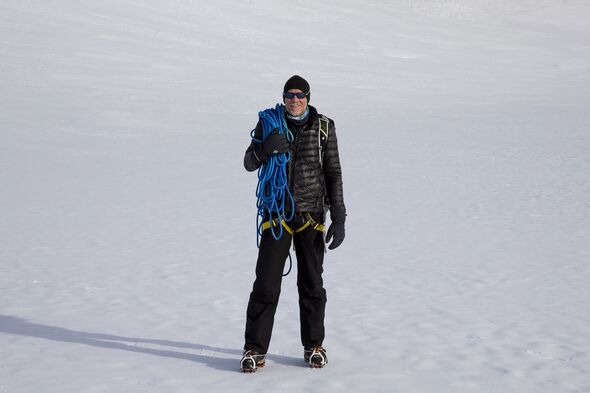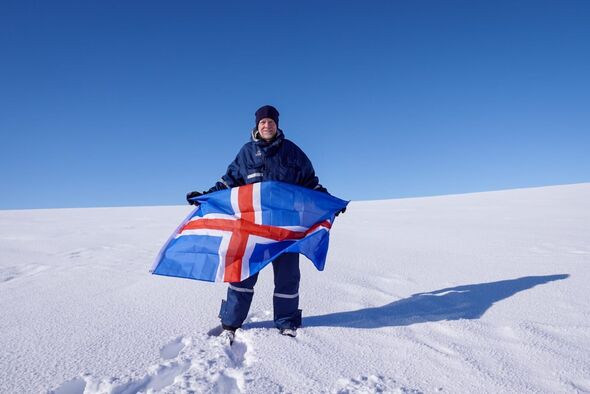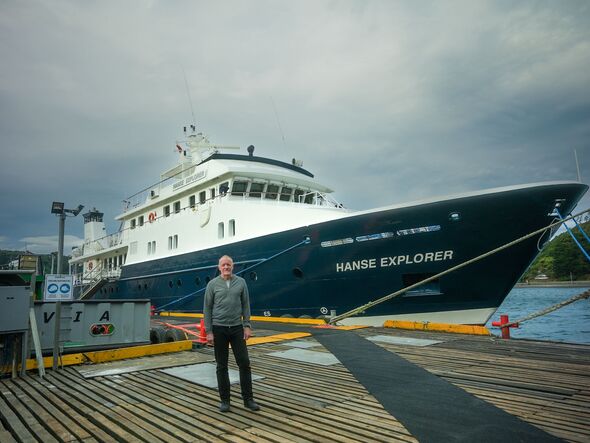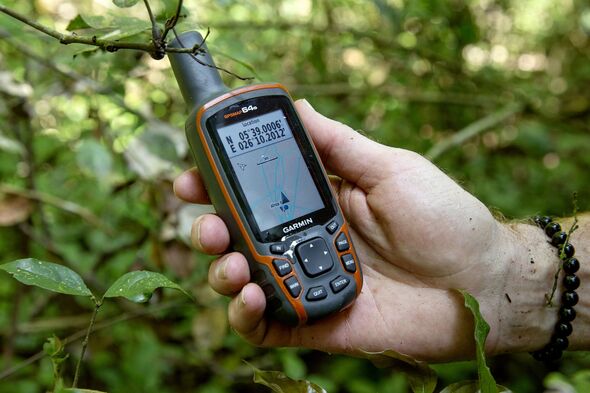Chris Brown by the ship taking him to Point Nemo (Image: JamPrime)
British explorer Chris Brown is sailing into history as the first person to lead an expedition to Point Nemo – the most remote oceanic spot on the planet.
And as the entrepreneur, 62, makes his way to the co-ordinates of the exact place furthest from any land on Earth, he tells the Daily Express he will mark the occasion by swimming at the eerily, quiet spot.
Chris, has already visited five of Earth’s seven ‘Poles of Inaccessibility’ – the furthest place on a continent from any sea – in Antarctica, Australia, Africa, North America and South America, with Europe and Asia still to do.
But since March 12th he and son Mika, 30, have been sailing aboard the Hanse Explorer ship from Chile to the Oceanic Pole of Inaccessibility, known as Point Nemo, in the Southern Pacific – aiming to reach it in 10 days.
The nearest land is the Pitcairn Islands 2,688km away, while the nearest humans are astronauts in the International Space Station, 408km above them in low earth orbit.
Explorer Chris Brown In Antarctica (Image: JamPrime)
Although sailors have travelled near Point Nemo, no expedition has specifically travelled to the exact spot since it was first discovered by Croatian engineer Hrvoje Lukatela in 1992 using geo-spatial technology.
Chris, from Harrogate, North Yorkshire, told the Daily Express it the opportunity of a lifetime to make history and continue his aim to reach the most remote places on the globe.
The father-of-two explained: “Maritime professionals say it’s quite possible nobody has ever been to Point Nemo – let alone specifically launch an expedition to there.
“Now there’s certainly been ships in that area and the big ocean race goes close, but organisers ay that Point Nemo isn’t a mark on their race.
“So there’s a chance that nobody has ever been there – now we aim to set that right with this expedition. The sole purpose of this trip is to go to exactly Point Nemo.”
And digital marketing tycoon Chris isn’t daunted by the potential perils they may face on the way, adding: “I don’t consider this to be as dangerous as my expeditions to Africa or Antarctica.
“The obvious danger is that you’re miles from anywhere on the sea, and you’re going to be a long way from any of the shipping lanes so if there was a problem with the boat, help would be a long time coming.
“I’ve been planning this specific expedition for months. But I’ve been looking at ways to get to Point Nemo for around six years. Lighter boats can obviously get there quicker but you’re going to be miles from anywhere so want something fairly robust.
“I then came across this boat called the Hanse Explorer which normally takes people to Antarctica in the summer which is winter in the Northern hemisphere.
“It is repositioning at the end of their ‘season’ from Chile in South America to French Polynesia. After a little negotiation, they agreed to go via the exact Point Nemo coordinates.”
Explorer Chris Brown in Iceland (Image: JamPrime)
Point Nemo was first identified by Hrvoje Lukatela 34 years ago using Digital Chart of the World data – with the name a reference to Jules Verne’s Captain Nemo from the novel 20,000 Leagues Under the Sea.
The first ship to sail close to Point Nemo was the Spanish research vessel Hespérides in 1999 and while ocean race competitors approach the area, it is not a ‘mark’ so the boats only need to be ‘close’ by.
Chris, Mika and their team sailed from Puerto Montt in Chile and are heading west for the exact map grid co-ordinates of Point Nemo – 45º52.6S, 123º23.6W.
They plan to take water samples at, and on the way to, Point Nemo in order to study the density of microplastics in this most-remote location in the oceans.
Point Nemo is in an area called The South Pacific Gyre which is a complex system of rotating currents in the Pacific; a convergence of The Antarctic Circumpolar Current, the Humboldt Current and the West Wind Drift.
As a result, lots of oceanic debris gets caught in the system and makes this area of the Pacific a sort-of oceanic garbage patch.
Chris Brown by ship Hanse Explorer taking him to Point Nemo (Image: JamPrime)
There are believed to be no fish or other marine life in the area with the lack of nutrients making it difficult for even the hardiest species to survive – and the ocean there is four kilometres deep and the surface water temperature 7C.
Currently, only bacteria and tiny crabs have been discovered to live in the volcanic vents on the seafloor nearby with scientists describing it as “the least biologically active region of the world ocean.”
And more than 100 pieces of space junk have been brought back down to Earth close to Point Nemo including the remnants of the Russian Mir Space Station.
The nearest land in each direction is – to the north Ducie Island, part of the Pitcairn Islands; to the northeast is Motu Nui, one of the Easter Islands and to the south Maher Island, part of Antarctica.
When Chris arrives at Nemo – the Latin for ‘no-one’ – he plans to go paddle boarding and enjoy a swim if the waters are calm enough.
He added: “I’m going to try and get in the water if it’s at all possible. I also expect I’ll open a bottle of bubbly when I get there!”
Chris Brown at African Point of Inaccessibilty (Image: JamPrime)
Chris hit the headlines around the world in June 2023 when it emerged that he pulled out of the doomed trip to the wreck of the Titanic on the Titan submersible – which later imploded killing five on board – amid safety concerns.
He was friends with British billionaire Hamish Harding, one of the five passengers on Titan and initially drawn to embarking on the expedition due to the historic and scientific possibilities.
Thrill-seeker Chris paid a deposit for the mission to the wreck along with now deceased billionaire Hamish Harding, 58, but he changed his mind when he saw the basic technology being used in the OceanGate craft.
Chris said: “I found out they used old scaffolding poles for the sub’s ballast — and its controls were based on computer game-style controllers.
“If you’re trying to build your own submarine you could probably use old scaffold poles. But this was a commercial craft.
Eventually I said, ‘I’m no longer able to go on this thing’. I asked for a refund after being less than convinced.”
* To keep updated by Chris on their expedition you can follow his TikTok Chris Brown (@chrisbrownexplores) | TikTok or to read more about his Poles of Inaccessibility ventures go to https://inaccessibility.net – and https://brown.co.uk

